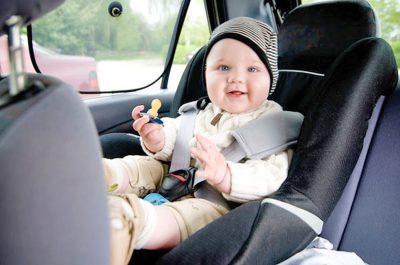September 10, 2019 – Washington Co., WI – With Child Passenger Safety Awareness Week scheduled for September 15-21, the Russ Darrow Group highlights the various automotive safety technologies designed to keep child occupants safe and secure when traveling.
“Arguably one of the most important child passenger safety features is a car seat or booster seat,” said Ivan Lawler, Director of Operations with the Russ Darrow Group. “In the unfortunate event of an accident, these are lifesaving devices.”
Car and booster seats are based on a child’s specific weight and age to guarantee the proper type of seat is used. Generally, rear-facing car seats are for newborns and small babies, forward-facing car seats are for toddlers and preschoolers, and booster seats are for school-aged children. “Be sure to follow the specific instructions that come with the car or booster seat to ensure proper installation,” Lawler said. “It’s imperative these guidelines are followed for their child as each type of car seat or booster seat is strategically designed to properly protect a child during certain phases of growth.”
LATCH systems, which stands for Lower Anchors and Tethers for Children, go hand in hand with car and booster seats. A standard safety feature on vehicles since 2002, the LATCH system consists of anchor and tether points designed to securely fasten car and booster seats to a vehicle’s passenger seat. Prior to the LATCH system, the safety belt was the only device used to secure a portable seat. “The LATCH system was invented to dramatically increase safety by ensuring the car or booster seat remains secure in the passenger seat, preventing it from shifting during travel,” said Lawler.
Another safety feature geared towards younger passengers is smart airbags. It’s strongly advised for children to ride in the back seat because airbags can be dangerous to those under age 13, but there are instances where this is not feasible. “A smart airbag system acknowledges these times, which is why the airbags deploys only when the system determines it’s safe to do so,” said Lawler.
Specifically, their activation is based on the likelihood of a potential injury, so if the risk of injury associated with airbag deployment far exceeds the risk of injury associated with the impact, the smart airbag will not deploy. Comprised of multiple sensors, smart airbags can detect the weight of a passenger and can also sense if a car or booster seat is present. More sophisticated versions can even control the force at which the airbags deploy and detect the exact position of a person in a seat. “For example, if a person is sitting too close to the dashboard, the smart airbag system will automatically deactivate,” he said.
Child safety locks are an imperative feature in vehicles as they prevent children from unlocking the doors from the inside. This gives the driver control over the locks, which is especially useful for preventing a child passenger from unlocking the doors and opening them, particularly when the vehicle is in motion.
In addition to controlling the locks from the driver’s seat, most vehicles give the driver the option to disable all power windows as well, preventing the child from accidentally pinching their hand or other body part. Plus, this feature discourages children from dropping toys or other items out of the vehicle, which is a potential road hazard for other drivers. “For added safety, newer versions of power window systems can detect even the slightest bit of resistance and will immediately stop rolling up to prevent possible injury,” said Lawler.
Although window tint may not be the first vehicle feature that comes to mind when thinking about child safety, it actually provides two crucial benefits to young passengers. First, it protects them from the harmful effects of UV rays. Typically, windshields on newer vehicles are treated with a special coating in order to protect the driver from UV rays. However, the rear windshield, side windows, and sunroof are not normally treated with a protective coating. Therefore, window tint is the ideal solution to protect passengers from UV radiation. Second, window tint significantly improves window strength. “Compared to non-tinted windows, tinted windows are much less susceptible to shattering in the event of a crash, which is an added safeguard for your children and other passengers,” he said.
A simple yet effective way to check on children in the back seat while behind the wheel is to install a mirror somewhere on or near the dash. That way, if children are eating or drinking in the vehicle, they can be easily viewed to ensure they don’t choke.
When it comes to parent drivers, nothing is more valuable to them than the safety of their children. With technology, the automotive industry has addressed parents’ concerns by introducing various child safety features designed to protect children as they travel in vehicles. “In recognition of Child Passenger Safety Awareness Week and throughout the year, remember to always drive cautiously and be responsible when it comes to your child’s security and well-being,” said Lawler.
Russ Darrow Group, headquartered in Menomonee Falls, is Wisconsin’s all-time volume auto retailer since 1965. Russ Darrow Group owns and operates dealerships in Milwaukee, Appleton, Green Bay, Madison, Waukesha, Wauwatosa, West Bend, and Greenfield representing Chrysler, Jeep, Dodge, Ram, Toyota, Honda, Nissan, KIA, Mazda, and Mitsubishi. With over 1,000 employees, the company also operates a nationwide fleet and leasing business and has its own in-house financing company.







